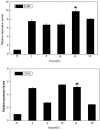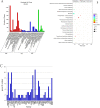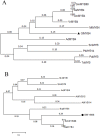Two responses to MeJA induction of R2R3-MYB transcription factors regulate flavonoid accumulation in Glycyrrhiza uralensis Fisch
- PMID: 32730299
- PMCID: PMC7392228
- DOI: 10.1371/journal.pone.0236565
Two responses to MeJA induction of R2R3-MYB transcription factors regulate flavonoid accumulation in Glycyrrhiza uralensis Fisch
Abstract
Flavonoids are key components of licorice plant that directly affect its medicinal quality. Importantly, the MYB family of transcription factors serves to regulate the synthesis of flavonoids in plants. The MYB transcription factors represent one of the largest families of transcription factors in plants and play important roles in the process of plant growth and development. MYB gene expression is induced by a number of plant hormones, including the lipid-based hormone jasmonate (JA). Methyl jasmonate (MeJA) is an endogenous plant growth regulator that can induce the JA signaling pathway, which functions to regulate the synthesis of secondary metabolites, including flavonoids. In this study, MeJA was added to licorice cell suspensions, and RNA-seq analysis was performed to identify the differentially expressed genes. As a result, the MYB transcription factors GlMYB4 and GlMYB88 were demonstrated to respond significantly to MeJA induction. Subsequently, the GlMYB4 and GlMYB88 protein were shown to localize to the cell nucleus, and it was verified that GlMYB4 and GlMYB88 could positively regulate the synthesis of flavonoids in licorice cells. Overall, this research helps illustrate the molecular regulation of licorice flavonoid biosynthesis induced by MeJA.
Conflict of interest statement
The authors have declared that no competing interests exist.
Figures









References
-
- Li YL, Yang Y, Fu CH, Yu LJ. Production of Glycyrrhizin in cell suspension of Glycyrrhiza inflata batalin cultured in bioreactor. Biotechnol Biotechnol Equip. 2012; 26(5): 3231–3235. 10.5504/BBEQ.2012.0083 - DOI
Publication types
MeSH terms
Substances
LinkOut - more resources
Full Text Sources
Molecular Biology Databases
Research Materials

